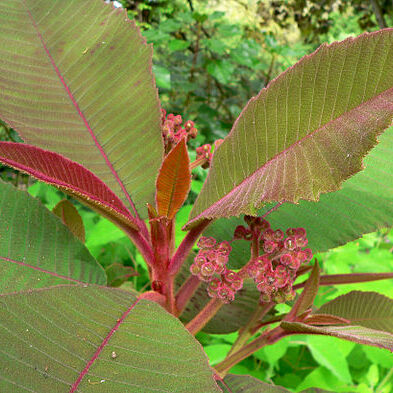Trees or shrubs. Branchlets usually with unguiculate hairs or subulate scales. Leaves petiolate; petiole scaly or not, rarely long setose; leaf blade tomentose or not abaxially, veins with scales or stiff hairs, numerous lateral veins diverging parallel to midvein, margin serrate. Inflorescences thyrsoid, paniclelike, composed of terminal cymes, solitary or fasciculate, usually scaly, tomentose or glabrous. Pedicels 2-bracteate. Flowers hermaphroditic or plants functionally dioecious. Sepals 5, strongly imbricate. Petals 5, imbricate, usually connate at base. Stamens 15-130; filaments adnate to base of petals; anthers obtrigonal, dorsifixed, dehiscing longitudinally or poricidally. Ovary 3-5-loculed, with many ovules per locule; styles 3-5, connate below middle, rarely free; stigma simple to discoid. Fruit baccate, white to pale green, rarely red, globose or depressed-globose, usually ribbed. Seeds brown, minute, areolate.
Trees or shrubs; branches usually brown, with whitish tubercular dots; branchlets and leaves mostly dense to sparsely pubescent. Leaves usually serrate, with parallel veins diverging from the midrib. Inflorescence lateral, often in axils of fallen leaves, cymose, subpaniculate. Bracts usually small, disjunct from the calyx. Flowers bisexual but functionally unisexual. Calyx pubescent to glabrous, persistent in fruit; sepals 5, strongly imbricate. Corolla glabrous, petals 5, usually connate at the base. Stamens numerous; filaments adnate to corolla at base; anthers apparently poricidal. Ovary globose, prominent or obsolete, normally glabrous, with (3–) 5 locules. Styles prominent, many, distinct or connate; ovules numerous. Fruit globose to ovoid berries that sometimes split open loculicidally; pulp mucilaginous; seeds numerous.

